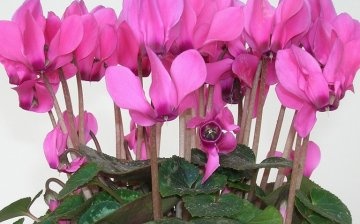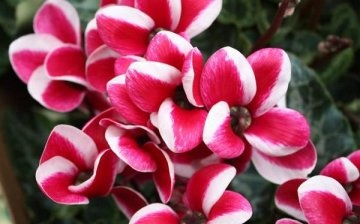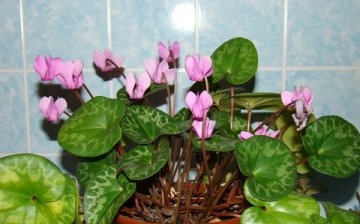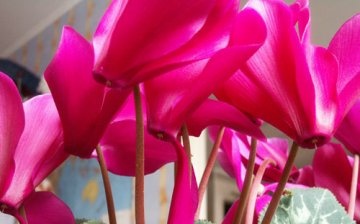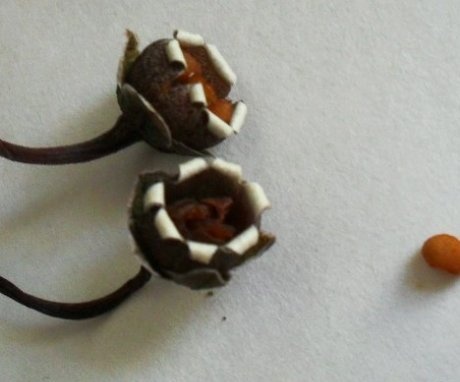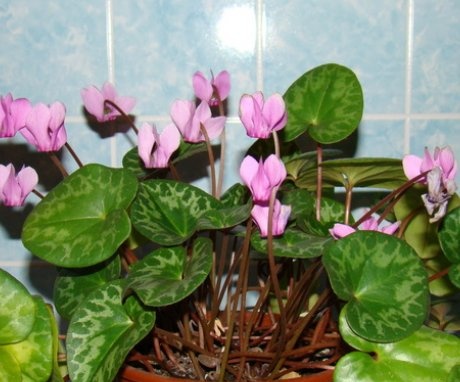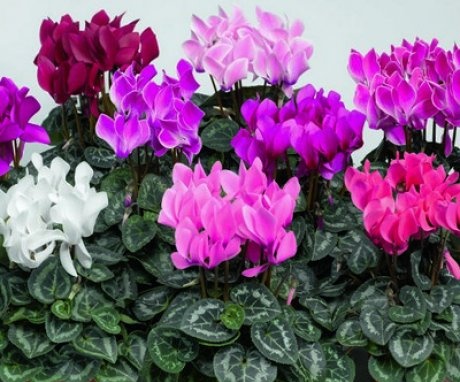Cyclamen: description, care and cultivation of indoor flowers
Cyclamen is a perennial tuberous plant, ranked in our latitudes as indoor flowering plants. However, in nature, this plant is considered to be wild from the Mirsinov family. Sometimes cyclamens are mistakenly referred to as Primroses. In fact, it is a herbaceous plant with a thickened root, distributed along the entire coast of the Mediterranean and the Black Sea, along the northeastern coast of Africa, in the Middle East, along the coast of the Caspian Sea, in the Kuban, in the Crimea and in southern Ukraine. The Cyclamen genus has more than 60 species of wild plants. Of these, only a little more than 20 species are indoor crops.
Content:
- Description of cyclamen
- Sowing and reproduction of cyclamen
- Cyclamen care
- Plant pests
- Varieties and varieties
- The healing properties of cyclamen
Description of cyclamen
The originality of the flowers of this plant attracts more admirers every day. Any of the florists is in awe of cyclamen. Cyclamens are really beautiful.
Features of the plant:
- The leaves of the plant resemble a heart-shaped bright dark green color with beautiful silvery stains of various configurations, collected in a root rosette.
- The leaves themselves have a decorative focus.
- Depending on the variety, cyclamens bloom at different times of the year, however, they are all in the heat and after flowering. become bare to the very tuber.
- Cyclamen tubers have a flattened rounded shape of different diameters, depending on the age of the plant.
- Most often, the diameter reaches 4-5 centimeters, but there are specimens with a diameter of 15 centimeters.
- There are buds along the surface of the root. Leaves and pedicels then grow from them.
In the period after flowering, the root is always dormant.
Cyclamens are ephemeroids, that is, they grow, bloom, bear fruit in the cool season. The more frost-resistant the cyclamen variety, the later they begin to bloom.
Flower characteristic:
- Cyclamen flowers arranged on tall, thin, but strong peduncles that rise above the foliage of the plant.
- The height of the flower legs sometimes reaches 30 centimeters. But there are dwarf varieties, where the peduncle does not exceed 12 centimeters.
- The flowers themselves are small, they can be of one or more colors.
- Colors: from white to bright purple.
- The flowers resemble a flock of butterflies circling above the plant.
- The peculiar structure of the flowers really resembles a fluttering butterfly, bright and unique from a distance.
- The main parts of the flower are bent downward, and the petals themselves are bent upward.
- All flowers have a pistil and stamens, being bisexual.
Cyclamen is good because the flowering period falls on the cold season, when nature loses its colors, when many people experience depression.
It was at this time that the houseplant cyclamen gives brightness and tenderness, beauty and good mood. The number of flowers per plant can be up to 60 units. If there is a cyclamen on the window, then depression is not terrible. Some varieties exude a subtle and delicate scent that fills the entire room.
Sowing and reproduction of cyclamen
However, growing a flower and waiting for it to bloom is not an easy task. It is difficult to grow this plant, especially from seeds. Only stubborn growers achieve positive results.
Sowing from seeds is done in autumn or spring.
You need the usual soil - soil for flowering plants, which can be found in specialized departments of stores. If blooming cyclamen is available, you can get your own seeds. This option is the most optimal, since the plant will be adapted to these conditions already during the germination period. The main thing is not to miss the moment of their full maturation and natural entry into the soil. Alternatively, you can simply purchase seeds from a retail outlet.
Propagation using seeds:
- Seeds are placed on slightly moistened soil, lightly press them into the ground and sprinkle them a little with moist peat on top.
- The pot is covered with a film and placed on a windowsill, where the sun is rare, and the air temperature does not exceed + 17 degrees Celsius, but not lower than +10. Seedlings will appear in a month.
- Then the sprouts are transplanted.
- The first time this is done after the appearance of the first leaves, the second transplant occurs after 2 months.
- At the first transplant, the tubers are completely covered with earth, and at the second, part of the root is left on top, covered with moss.
The result of such a reproduction of cyclamen gives only after 1-2 years.
That is why it is easier and easier to breed this plant with tubers. To do this, the daughter growths are carefully separated from the main root and planted in a pot of soil... There he grows and develops. It is necessary to monitor the moisture content of the earth, avoiding increased soil moisture, overdrying and warming. Such plants begin to bloom faster.
Cyclamen care
Indoor flowers cyclamen are very sensitive to different care errors. This plant is designed for large cool rooms, verandas, loggias. Wet peat, in which the pot with the plant is immersed, will give the soil the optimum temperature. Spraying air around the flower will be a useful manipulation.
Watering the plant:
- But you cannot overmoisten the soil itself. Excess moisture causes rotting of tubers and leaves.
- After a period of flowering and complete loss of leaves, the pot of tuber and soil is transferred to a dormant state.
- To do this, stop watering, put the pot on its side and place it in a dark, cool place.
- From the middle of summer, the pot is exposed, the soil is lightly watered.
- After the appearance of the first leaves, the cyclamen is transplanted.
It should be remembered that sunlight should not directly hit the plant, however, it is preferable to choose a bright location for the flower, with diffused light.
Watering cyclamen is best done from belowpouring water into the pan. Liquid contact with the plant is fraught with the death of the flower. It is gray rot that is the most dangerous enemy of cyclamens. It is necessary to try to avoid high soil moisture. It is very beneficial to fertilize plants during flowering and growth. Mineral fertilizers are good for this.
There are some problems in growing cyclomenes:
- Decay of roots, petioles. This is caused by careless watering and excessively warm air temperatures for this plant.
- Yellowing of leaves along with strong flowers. This is due to the presence of a dry climate, high air temperatures for cyclamens, poor watering, exposure to sunlight.
- The short flowering period is due to irregular and irregular watering, poor soil, dry climate.
- Flowers are "hidden" under the leaves of plants that are in damp conditions, cold rooms, irregularly watered.
To avoid various problems in growing cyclamen, you should adhere to the rules of their cultivation and care. And timely loosening of the soil will improve the result.
Plant pests
The plant should be protected from pests. The most dangerous are:
- An elephant beetle that nibbles on leaves, and its larvae feed on tubers.
- Scabbard that infects leaves.
- Thrips appears when overheated and waterlogged, leading to leaf damage.
- Cyclamen mite that infects buds and leaves.
That is why it is necessary to periodically inspect the plants, remove the affected parts, and process them with soap or tobacco solution.
The use of pesticides is an emergency measure. But if damaged by pests, insecticide treatment is required, otherwise the plant will die.
Varieties and varieties
There are many varieties of this beautiful plant. But the most popular among florists are:
- Cyclamen African. A large species with large leaves. Prefers stony soil. Blooms from September to November. The flowers range in color from pale pink to dark pink.
- Balearic cyclamen. A small representative of the genus. Leaves on the inside are crimson. And the flowers have different colors: from white to pale pink.
- Cyclamen of Cilician. Small leaves with silver spots. The flowers are light pink with a purple spot at the base of the rosette. Prefers shade.
- Cyclamen Pontic or Colchis. Differs in small flowers and foliage without a pattern.
- Cyclamen kosky. It differs from others in the presence of a dark spot on the leaves, the growth of roots from the bottom of the tubers and large flowers. The flowers are bright pink in color.
- Alpine violet is distinguished by its love of shade and the brightness of colors of flowers and buds.
- Cypriot cyclamen. The flowers have purple spots at the base, the petals themselves are white. They have a strong aroma.
- Cyclamen is graceful. It has small leaf sizes and bright flowers.
- Cyclamen Greek. Has a varied color of petals with a purple spot at the base. Has the brightest and most colorful combinations.
- Cyclamen neapolitan or ivy. Prefers warmth. It is often used as a garden plant. The leaves are like ivy leaves. Blooms pink.
- Cyclamen Lebanese. The leaves have yellow specks and the flower petals are pink-purple.
- Cyclamen is amazing. Differs in leaves with teeth and petals of different tones with purple at the base of the rosette.
- The cyclamen is small-colored. It has short stalks, small flowers, small leaves. The flowers are often purple in color.
- Cyclamen Turkish. It has small leaves and large flowers. Flowers can be lilac, purple, red, but always have a chocolate spot at the base. The leaves are always glossy.
- Cyclamen Persian. The dark marbled leaves are combined with flowers of different shades, from pink to red.
- Cyclamen is European. A large plant with large leaves and tall large flowers. Unlike many types of cyclamen, it blooms not in autumn, but from June to August. The color of the petals ranges from white to carmine.
- Somali cyclamen. Small variety with pink flowers.
There is still many types of cyclamen, but they are less common in florists as indoor crops. There is a unique species of this plant - Kuznetsov's cyclamen. This plant is listed in the Red Book. Its uniqueness is that the flowering period begins in spring.
The healing properties of cyclamen
It has been known since the 15th century that cyclamen is medicinal plant... However, using it on its own can do more harm than good. This is due to the fact that the sap of the leaf plant, depending on its type, can be poisonous.
Most often, the juice of the tubers is used in a diluted form.
An infusion or decoction of cyclamen tubers is used to treat:
- Runny nose.
- ARI.
- ARVI.
- With nervous diseases.
Avicenna also recommended plant juice for the treatment of purulent focal lesions, for eye diseases, for migraines and for instilling the nose. But it is better to use ready-made preparations based on cyclamen.
More information can be found in the video.



